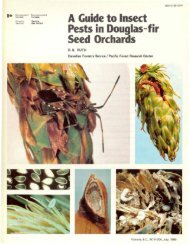decay of aspen and balsam poplar in alberta - Canadian Forest ...
decay of aspen and balsam poplar in alberta - Canadian Forest ...
decay of aspen and balsam poplar in alberta - Canadian Forest ...
You also want an ePaper? Increase the reach of your titles
YUMPU automatically turns print PDFs into web optimized ePapers that Google loves.
al. 1960). Decay caused by unkn'Own organisms<br />
accounted for 38.2% (34.7% <strong>of</strong> trunk <strong>in</strong>fections <strong>and</strong><br />
3.5% <strong>of</strong> butt <strong>in</strong>fections), which is greater than <strong>decay</strong><br />
volume due to P. tremulae (26.8%) (Thomas et al.<br />
1960). More <strong>in</strong>vestigations are needed to determ<strong>in</strong>e the<br />
unknown organisms caus<strong>in</strong>g the <strong>decay</strong> <strong>in</strong> this species <strong>and</strong><br />
the relative importance <strong>of</strong> <strong>decay</strong> fungi.<br />
Many bacteria <strong>and</strong> other fungi are constantly<br />
isolated from <strong>decay</strong>ed <strong>and</strong> sta<strong>in</strong>ed tissues (Etheridge<br />
1961; Good <strong>and</strong> Nelson 1962; Laflamme <strong>and</strong> Lortie<br />
Aspen <strong>and</strong> <strong>balsam</strong> <strong>poplar</strong> are shade· <strong>in</strong>tolerant<br />
species. hence they tend to grow <strong>in</strong> even-aged st<strong>and</strong>s.<br />
These st<strong>and</strong>s orig<strong>in</strong>ate primarily by means <strong>of</strong> sucker<strong>in</strong>g<br />
after forest fires or logg<strong>in</strong>g. Regeneration <strong>of</strong> shade<br />
<strong>in</strong>t'Olerant <strong>aspen</strong> <strong>and</strong> <strong>balsam</strong> <strong>poplar</strong> ceases when the<br />
forest canopy is closed.<br />
Age-<strong>decay</strong> relationships are usually tabulated <strong>in</strong><br />
10-20 year classes; theref'Ore, all published age-<strong>decay</strong><br />
relationships show <strong>decay</strong> percentages <strong>of</strong> <strong>aspen</strong> <strong>and</strong><br />
<strong>balsam</strong> <strong>poplar</strong>-that are ranked by the ages <strong>of</strong> unrelated,<br />
noncomparable <strong>aspen</strong> <strong>and</strong> <strong>balsam</strong> <strong>poplar</strong> st<strong>and</strong>s.<br />
Because each st<strong>and</strong> is unique with respect to fire history,<br />
genetic orig<strong>in</strong>, site quality, <strong>and</strong> species composition,<br />
there is a great variability <strong>in</strong> the data ·published by<br />
different researchers. Tables 2 <strong>and</strong> 3 demonstrate how<br />
<strong>aspen</strong> <strong>decay</strong> <strong>and</strong> <strong>balsam</strong> <strong>poplar</strong> <strong>decay</strong> percentages vary<br />
across Canada <strong>and</strong> the United States. A second major<br />
cause <strong>of</strong> the high variability <strong>of</strong> data published on age·<br />
<strong>decay</strong> relationships <strong>in</strong> <strong>aspen</strong> <strong>and</strong> <strong>balsam</strong> P'Oplar relates to<br />
the lack <strong>of</strong> clear dist<strong>in</strong>ction between <strong>in</strong>cipient <strong>and</strong><br />
advanced <strong>decay</strong> <strong>and</strong> between sta<strong>in</strong> <strong>and</strong> <strong>in</strong>cipient <strong>decay</strong>.<br />
A third cause <strong>of</strong> variability is the selection <strong>of</strong> different<br />
assessment st<strong>and</strong>ards <strong>in</strong> the various <strong>decay</strong> <strong>and</strong> cull<br />
surveys.<br />
Pedology Consultants (1982) analyzed 10 15 trees<br />
<strong>in</strong> the O'Chiese Block <strong>of</strong> the Rocky.Clearwater <strong>Forest</strong>.<br />
Fire history <strong>in</strong> this forest district has restric·ted the growth<br />
Frequently, a wide range 'Of diameters exists <strong>in</strong><br />
even-aged <strong>aspen</strong> st<strong>and</strong>s because <strong>of</strong> variati'Ons <strong>in</strong> site<br />
quality <strong>and</strong> competition by surr'Ound<strong>in</strong>g trees. This<br />
makes it difficult to obta<strong>in</strong> correlations between tree age<br />
1973; Shigo 1967; Thomas et aI. 1960). These are not<br />
c'Onsidered <strong>decay</strong>·caus<strong>in</strong>g organisms, but they are<br />
believed t'O play an important role-<strong>in</strong> microbial succession<br />
lead<strong>in</strong>g to <strong>in</strong>cipient <strong>decay</strong> <strong>in</strong> <strong>aspen</strong> <strong>and</strong> <strong>poplar</strong>_<br />
On trembl<strong>in</strong>g <strong>aspen</strong>, blackish galls with a rough<br />
surface are <strong>of</strong>ten found (Fig. 15), but the <strong>in</strong>terior <strong>of</strong> the<br />
galls is sound <strong>and</strong> not ass'Ociated with <strong>decay</strong>. Except for<br />
one tree with large scars <strong>and</strong> conks, about 20 trees with<br />
black galls did not have conks <strong>and</strong> did not have<br />
advanced <strong>decay</strong>l.<br />
AGE-DECAY RELATIONSHIPS<br />
SITE-DECAY RELATIONSHIPS<br />
t Field observations at Blue Ridge, Alberta, <strong>in</strong> 1982 by Y. Hiratsuka <strong>and</strong> A.A. Loman.<br />
<strong>of</strong> <strong>aspen</strong> <strong>and</strong> <strong>balsam</strong> <strong>poplar</strong> st<strong>and</strong>s to s<strong>in</strong>gle age classes.<br />
Eighty-five percent <strong>of</strong> their 1015 sample trees were over<br />
45 years old, <strong>and</strong> the average age was 70 years. Their<br />
estimated <strong>decay</strong> percentage was 8.7% f'Or <strong>aspen</strong> <strong>and</strong><br />
7.40/0 for <strong>balsam</strong> <strong>poplar</strong> <strong>and</strong> did not <strong>in</strong>clude unmerchant<br />
able stems. Only merchantable sawlogs with less than<br />
50% <strong>decay</strong> <strong>and</strong> hav<strong>in</strong>g more than 9.0 cm top diameter<br />
were analyzed. Bailey <strong>and</strong> Dobie (1977) employed<br />
similar st<strong>and</strong>ards <strong>of</strong> utilization, <strong>and</strong> obta<strong>in</strong>ed comparable<br />
results (Tables 1 <strong>and</strong> 2). Paul <strong>and</strong> Etheridge (1958)<br />
analyzed <strong>decay</strong> <strong>and</strong> cull relationships at the logg<strong>in</strong>g site.<br />
For <strong>aspen</strong> they show nearly five times more <strong>decay</strong> (30%)<br />
<strong>in</strong> the 51·60 year age class than Bailey <strong>and</strong> Dobie<br />
(6.2%), five times more <strong>decay</strong> <strong>in</strong> the 71·80 years age<br />
class, <strong>and</strong> three times more <strong>decay</strong> <strong>in</strong> the 91-100 years<br />
age class. For <strong>balsam</strong> <strong>poplar</strong>, Bailey <strong>and</strong> Dobie show<br />
nearly equal <strong>decay</strong> percentages throughout 140 years <strong>of</strong><br />
age (range 0.7%), while Paul <strong>and</strong> Etheridge show a<br />
range <strong>of</strong> 21.6% through 170 years <strong>of</strong> age.<br />
In general, <strong>decay</strong> percentages <strong>of</strong> gross volume<br />
<strong>in</strong>crease with age; however, c'Omparisons between pub<br />
lished results obta<strong>in</strong>ed by different researchers across<br />
Canada <strong>and</strong> the United States are difficult. Although<br />
preselection <strong>and</strong> rejecti'On <strong>of</strong> unmerchantable logs at the<br />
logg<strong>in</strong>g site give low <strong>decay</strong> <strong>in</strong>cidence figures <strong>in</strong> s'Ome<br />
surveys (Bailey <strong>and</strong> Dobie 1977; Pedology Consultants<br />
1982), the high labor costs <strong>of</strong> fell<strong>in</strong>g, cutt<strong>in</strong>g, <strong>and</strong><br />
select<strong>in</strong>g may make the operation uneconomical.<br />
<strong>and</strong> diameter. When diameter limit cuts provided the<br />
stems for <strong>decay</strong> <strong>and</strong> volume analyses (Bailey <strong>and</strong> Dobie<br />
1977; Pedology Consultants 1982), poor correlations<br />
were found between age <strong>and</strong> <strong>decay</strong> (Tables 2 <strong>and</strong> 3).<br />
9



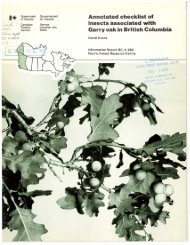
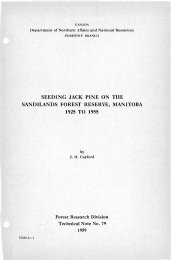
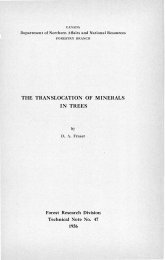
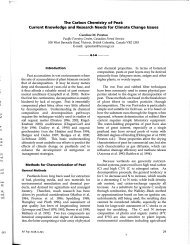


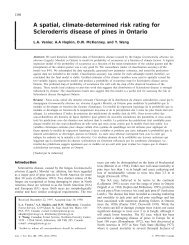

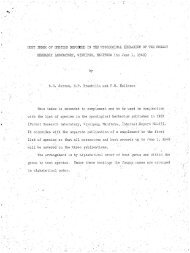
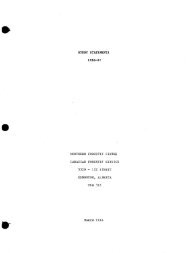
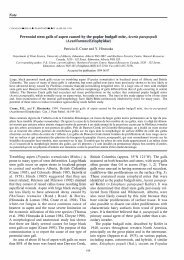
![Po],rell](https://img.yumpu.com/11946277/1/190x231/porell.jpg?quality=85)
